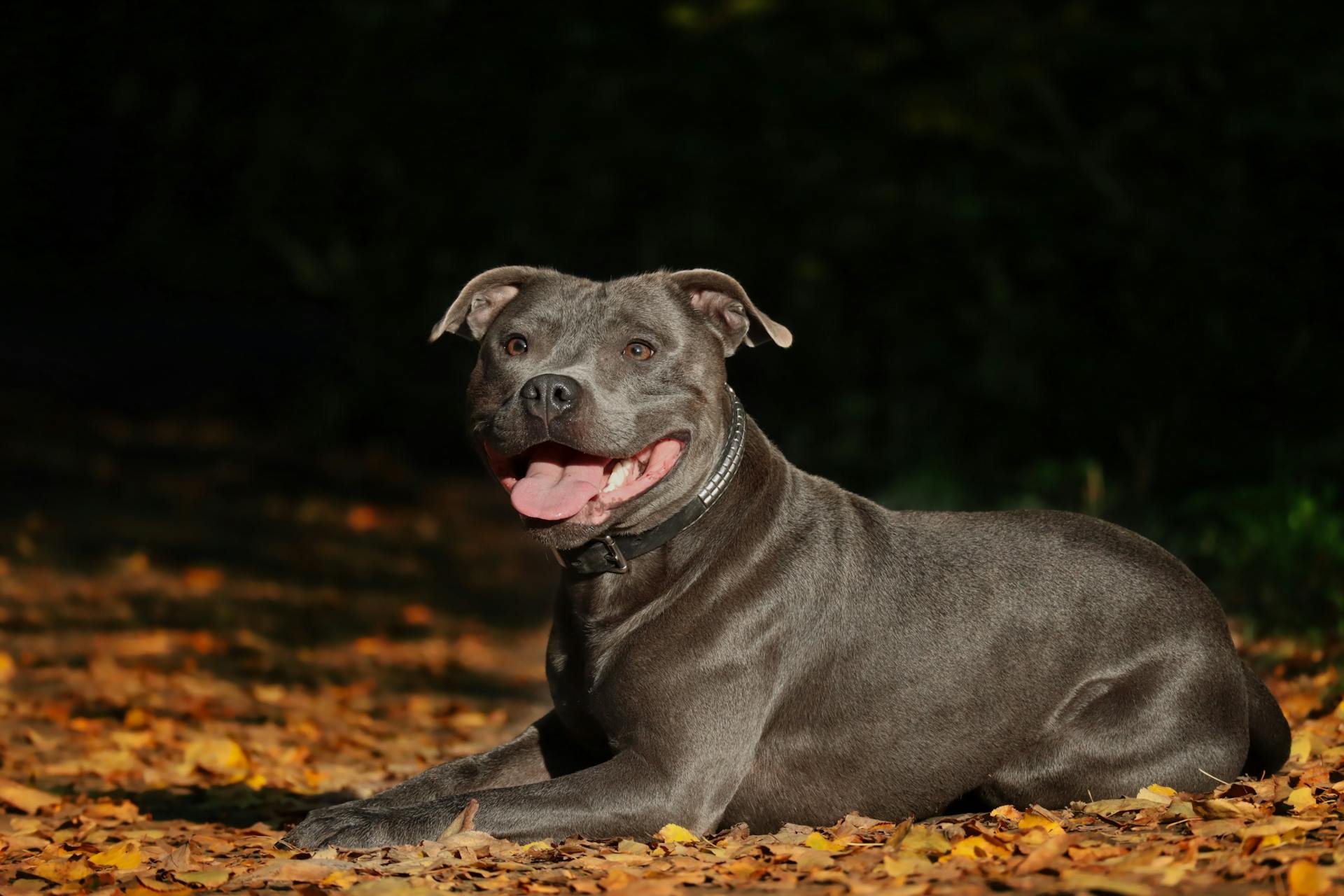
Mammary cancer in dogs is a serious health issue that affects many canine companions. It's the most common type of cancer in intact female dogs.
Mammary cancer can occur in any intact female dog, regardless of age or breed.
Dogs with a family history of breast cancer or those who have had previous mammary tumors are at a higher risk of developing the disease.
Readers also liked: Dog Mammary Tumor Removal Cost
Causes and Risk Factors
Prolonged exposure to estrogens and progestins is associated with increased risk of mammary tumors in dogs. This is because these hormones stimulate growth factors that cause mammary cells to multiply.
Female dogs that have undergone ovariohysterectomy (OHE) prior to their first estrus have a very low incidence of mammary tumors. In fact, their risk is only 0.5%.
Sexually intact female dogs, on the other hand, have a relatively high overall risk of mammary tumors, with 50-70% of all tumors in this subpopulation being mammary in origin. This highlights the importance of spaying your dog before the first heat cycle.
For your interest: Mammary Cancer in Dogs Pictures
Risk Factors

Prolonged exposure to estrogens and progestins is associated with a significantly increased risk of mammary tumors in dogs.
Female dogs that have undergone ovariohysterectomy (OHE) prior to their first estrus have a very low incidence of mammary tumors.
Sexually intact female dogs have a relatively high overall risk of mammary tumors, with 50-70% of all tumors in this subpopulation being mammary in origin.
The risk of mammary tumors increases gradually with age, with the average age of dogs with tumors being 7-11 years old.
Dogs that are spayed after the third estrus cycle do not have a decreased risk of mammary tumors, according to some studies.
However, spaying older dogs can still decrease the risk of new tumors, with one study showing a significantly decreased risk for new tumors in older sexually intact dogs that were spayed (36% vs 64%).
Exposure to exogenous estrogens or progestins also increases the risk of tumor development.
Certain breeds, such as Chihuahuas, Poodles, Dachshunds, and Yorkshire Terriers, appear to be more commonly affected by mammary tumors.
The risk of mammary tumors is also associated with factors such as obesity and a diet high in red meat.
Related reading: Canine Brain Tumors
Metastasis
Metastasis plays a significant role in the prognosis of dogs with cancer. The presence of metastases in regional lymph nodes has been linked to an increased risk of tumor recurrence.
Dogs with metastases in regional lymph nodes are more likely to experience a poorer outcome. In fact, they are more than three times as likely to have a tumor recurrence.
The presence of distant metastases is also a critical factor in determining overall survival. Dogs with no metastases are more than three times as likely to survive one year from diagnosis.
You might enjoy: Canine Transmissible Venereal Tumor
Hemostatic Abnormalities
In dogs with mammary carcinoma, hemostatic abnormalities are a common issue, affecting around 67% of cases.
The incidence of hemostatic abnormalities increases with the histologic grade of the tumor.
Hemostatic abnormalities are more common in dogs with metastasis, extensive necrosis, inflammatory carcinoma, fixed tumors, or histologic evidence of penetration of the tumor capsule.
Abnormal hemostatic parameters include platelet count, PT, APTT, thrombin time, plasma activity of factors V, VIII and X, plasma concentrations of fibrinogen, fibrin monomers and FDP, and AT-III.
Tumor Characteristics
Mammary cancer in dogs is a common issue, especially in intact females.
Most mammary tumors in dogs are benign, but some can be malignant.
The most common types of mammary cancer in dogs are carcinomas, which account for about 85% of cases.
Mammary cancer in dogs can be divided into three stages: Stage I, Stage II, and Stage III, with Stage III being the most advanced.
The prognosis for dogs with mammary cancer varies depending on the stage and type of cancer, but early detection and treatment can improve survival rates.
Tumor Size
Tumor size is a critical factor in determining the prognosis for a dog with a mammary mass. Dogs with tumors less than 3 cm in diameter have a significantly better prognosis.
Dogs with tumors larger than 5 cm in diameter are more likely to develop metastases. They are also seven times more likely to die in the first two years after surgery.
A smaller tumor size is a good sign, and it's essential to catch these tumors early to improve the chances of successful treatment and a longer survival time.
Inflammatory Carcinoma
Inflammatory carcinoma is a type of tumor that can be challenging to diagnose.
Inflammatory mammary carcinomas are associated with the diestrous phase of the estrous cycle, which may play a role in their development.
These tumors can appear significantly earlier after the last estrus, often within 52 days.
They are characterized by diffuse swelling of the mammary tissue with poor demarcation between normal and abnormal tissue.
In many cases, physical examination findings reveal diffuse involvement of both mammary chains in 55% of cases.
Other common symptoms include a palpable mammary mass in 24% of cases and pelvic limb edema and lameness in 61% of cases.
Lymphedema in the pelvic limb adjacent to the inflammatory carcinoma can occur due to occlusion of lymphatics and retrograde growth of the tumor.
Inflammatory carcinomas can be confused with acute mastitis, which is characterized by localized swelling associated with estrous or false pregnancy.
Here are some key differences between inflammatory carcinoma and acute mastitis:
- Inflammatory carcinoma causes diffuse swelling, while acute mastitis causes localized swelling.
- Inflammatory carcinoma is associated with the diestrous phase of the estrous cycle, while acute mastitis is associated with estrous or false pregnancy.
Tumor Presence Duration
Dogs with a mammary malignancy longer than six months are more likely to develop metastases.
The longer a tumor is present, the more time it has to spread to other parts of the body.
Dogs with tumors removed soon after diagnosis have a better chance of recovery.
A tumor's presence duration can significantly impact the outcome of treatment and the overall health of the dog.
Treatment Options
Surgery is the best treatment for dogs with mammary tumors, especially if the tumors are small and there's no evidence of spread. In fact, for dogs with solitary mammary tumors, surgery may be the only treatment needed.
For dogs with multiple tumors or larger tumors, the associated mammary glands may need to be removed, and in some cases, an ovariohysterectomy (spay) is recommended and may be done at the same time as the mammary gland removal.
Chemotherapy may be recommended for dogs with larger tumors or evidence of spread to other areas of the body, and in some cases, radiation therapy may provide some benefit in addition to chemotherapy.
You might enjoy: Canine Cancer Treatment
Here are some chemotherapy options for dogs with mammary tumors:
- No known effective adjuvant chemotherapy protocol for malignant or metastatic mammary tumors
- Doxorubicin has some antitumor effect against mammary ADC and has been associated with partial responses in dogs with metastatic mammary ADC
- 5-fluorouracil and cyclophosphamide combination significantly improves survival time in dogs with high-risk mammary carcinomas following surgical resection
- Piroxicam combined with radiation therapy is the best treatment for dogs with inflammatory mammary carcinoma
Systemic Treatment
Systemic treatment is an option for dogs with high-risk mammary tumors or those that have spread to other areas of the body. Chemotherapy is typically recommended in these cases.
Dogs with estrogen-positive tumors may benefit from ovarian hormonal ablation, which can be achieved through a procedure called OHE. This has been shown to decrease the incidence of new tumors and delay the incidence of distant metastasis in some cases.
Chemotherapy with or without NSAIDs is often used as an adjuvant in dogs at high risk of metastasis or as a palliative for dogs with established metastasis. However, the effectiveness of these treatments in dogs is not well established, and more research is needed.
Some chemotherapy agents have shown potential in vitro activity or efficacy in clinical trials, including 5-fluorouracil, cyclophosphamide, doxorubicin, carboplatin, and mitoxantrone. However, the leap from in vitro studies to clinical efficacy can be significant.
Expand your knowledge: Is High Protein Dog Food Good for Dogs
Here are some chemotherapy agents that have shown potential in treating mammary tumors in dogs:
- 5-fluorouracil and cyclophosphamide combination significantly improves survival time in dogs with high-risk mammary carcinomas following surgical resection
- Doxorubicin has some antitumor effect against mammary ADC and has been associated with partial responses in some dogs
- Cyclophosphamide and doxorubicin or cisplatin have some antitumor effect against mammary ADC
- Piroxicam combined with radiation therapy is the best treatment for dogs with inflammatory mammary carcinoma
- Bisphosphonates and palliative radiation therapy for metastatic bone lesions
It's essential to consult with a veterinarian to determine the best course of treatment for your dog's specific situation.
Immunotherapy
Immunotherapy is a treatment approach that aims to stimulate the body's immune system to fight cancer. Unfortunately, it's not a guarantee of success.
Non-specific immunomodulation, which involves using substances like levamisole and Corynebacterium parvum with BCG, has been tested in combination with surgery, but the results are underwhelming. In fact, studies have shown that this approach has no significant effect compared to surgery alone.
On the other hand, liposome-encapsulated muramyl-tripeptide phosphatidylethanolamine, a derivative of mycobacterial cell wall, has been tested in dogs with invasive mammary carcinoma. Unfortunately, it's not effective in treating this type of cancer.
Here are some key points to keep in mind:
- Non-specific immunomodulation with levamisole and Corynebacterium parvum with BCG combined with surgery has no significant effect compared to surgery alone.
- Liposome-encapsulated muramyl-tripeptide phosphatidylethanolamine is not effective in dogs with invasive mammary carcinoma.
Prevention and Key Points
Early neutering can reduce the risk of mammary cancer in dogs. However, it's essential to balance this consideration against other factors.
Mammary tumors are the most common tumor type in female dogs. This is a significant concern for many dog owners.
Early spaying may mitigate the risk of mammary tumors, but it's not the sole consideration in timing of spaying. Other health effects, such as increased risk of hemangiosarcoma, osteosarcoma, and lymphoma, must also be taken into account.
Surgical excision of all tumors provides for histopathological diagnosis and locoregional control. This is a crucial step in treating mammary tumors.
Here are some key points to keep in mind:
- Mammary tumors can be prevented through early ovariohysterectomy (OHE).
- However, OHE at an early age may increase the risk of hemangiosarcoma, osteosarcoma, and lymphoma.
- Owners of breeds at risk for these aggressive malignancies are often advised to delay OHE.
- Regular examinations at home can help detect mammary tumors early, when treatment is often associated with favorable outcomes.
Veterinary Care and Team
It's essential to have a veterinary team that's experienced in diagnosing and treating mammary cancer in dogs. A veterinary oncologist or a veterinarian with experience in treating mammary cancer can provide the best care for your dog.
The veterinary team will typically perform a physical examination, take a complete medical history, and order diagnostic tests such as a fine-needle aspiration or a biopsy to confirm the diagnosis of mammary cancer.
Pathogenesis and Histology
Mammary tumors in dogs are hormone-dependent, which means their growth is influenced by ovarian hormones, such as estrogens and progesterone.
The most common sites of metastasis, or where the cancer spreads, are regional lymph nodes, lungs, liver, and kidneys.
A complex dysregulation of hormones and growth factors is involved in canine mammary tumorigenesis, making it a multifaceted process.
Tumors are classified based on their histopathologic characteristics, which include the degree of nuclear differentiation and the presence of lymphoid accumulation.
The more highly differentiated the tumor, the better the prognosis, with well-differentiated tumors having a 24% chance of recurrence compared to poorly differentiated tumors, which have a 90% chance of recurrence.
Dogs with inflammatory carcinomas have a poor prognosis and may be mistaken for mastitis due to similar clinical symptoms.
Histopathologic Examination
Histopathologic examination is a crucial step in understanding the nature of a canine mammary tumor. It helps determine the prognosis and guides treatment decisions.
Several histopathologic grading schemes are of prognostic significance, with important factors including histopathologic classification, degree of nuclear differentiation, and the presence of lymphoid accumulation. The more highly differentiated the tumor, the better the prognosis.
Dogs with poorly differentiated tumors have a much higher chance of recurrence, with 90% of such tumors recurring within two years. In contrast, well-differentiated tumors have a much lower risk of recurrence, with only 24% recurring within two years.
Dogs without lymphoid cellular reactivity at the time of initial mastectomy have a three-fold increased risk of developing recurrence within two years, compared to those with such reactivity. This highlights the importance of lymphoid cellular reaction in tumor vicinity, which may represent an immunologic antitumor response.
The prognosis varies across different histopathologic subtypes of canine mammary tumors, ranging from a relatively low risk of recurrence in dogs with complex carcinomas to very short survival in dogs with anaplastic carcinomas and carcinosarcomas.
Here's a summary of the prognosis for different histopathologic subtypes:
This information is crucial for veterinarians to make informed decisions about treatment and for dog owners to understand the prognosis of their pet's condition.
Pathogenesis
Mammary tumors in dogs are hormone dependent, which means they're influenced by the body's hormonal balance.
The most common sites of metastasis are regional lymph nodes, lungs, liver, and kidneys, so it's essential to keep an eye out for any unusual symptoms in these areas.
Canine mammary tumorigenesis involves a complex dysregulation of ovarian hormones, specifically estrogens and progesterone, which play a crucial role in the development of these tumors.
This hormonal imbalance can lead to the growth and spread of cancer cells, making it a critical aspect of understanding mammary tumors in dogs.
Hormonal and Progestin Factors
Female dogs that have undergone ovariohysterectomy (OHE) prior to their first estrus have a very low incidence of mammary tumors. This is because they are exposed to fewer ovarian hormones.
Prolonged exposure to estrogens and progestins is associated with increased risk of mammary tumors in dogs. Exogenous progestins, such as medroxyprogesterone acetate, can induce lobuloalveolar development of mammary glands with hyperplasia of secretory myoepithelial elements.
Exposure to exogenous estrogens or progestins can also increase risk of tumor development. For example, 19-nortesterone causes mammary carcinoma in 40% of treated dogs.
Here are some key hormonal factors associated with mammary tumor risk:
- Estrogen-receptor and progesterone-receptor positive tumors have a better prognosis.
- Receptor-positive tumors are likely to be benign.
- Exposure to exogenous estrogens or progestins increases risk of tumor development.
- Exogenous progestins, such as medroxyprogesterone acetate, can induce lobuloalveolar development of mammary glands.
Hormonal Therapy
Hormonal therapy is a topic of debate when it comes to treating mammary tumors in dogs. Hormonal therapy may be ineffective because malignant mammary tumors often lack steroid receptors.
The effectiveness of hormonal therapy depends on the presence of specific receptors in the tumor. Tumors that express estrogen, progesterone, or prolactin receptors may be more responsive to hormonal therapy.
Tamoxifen, a mixed anti-estrogen, has been used in women with estrogen receptor-positive breast cancers, but its effectiveness in dogs is limited. In one study, Tamoxifen showed antiproliferative activity in vitro, but had a limited response in vivo, with a mean survival time of 4 months.
Adverse effects of Tamoxifen preclude its routine use, including vulvar swelling, vaginal discharge, incontinence, UTI, stump pyometra, and signs of estrous. LHRH analogue (Goserilin) has been shown to reduce circulating levels of estradiol and progesterone, and had some antitumor activity in 53% of dogs with estrogen receptor-positive mammary carcinoma.
Here's a summary of the potential benefits and drawbacks of hormonal therapy for mammary tumors in dogs:
Ovariectomy Status
Research suggests that ovariectomy status plays a significant role in the survival rate of dogs with mammary tumors. Dogs that were intact at the time of surgery for a mammary carcinoma had a median survival of 9.5 months, whereas those ovariectomized within two years before surgery survived for 25 months.
Intact dogs were also more likely to have solid and anaplastic carcinomas, with 80 percent of them having this type of tumor. In contrast, dogs ovariectomized within two years of surgery had only 20 percent solid carcinomas.
Interestingly, another study found that dogs that were not intact at the time of diagnosis were 2.5 times more likely to survive two years after surgical excision of the mammary malignancy.
Frequently Asked Questions
How long will a dog live with mammary gland cancer?
A dog's survival time with mammary gland cancer can range from 1 month to almost 2 years, depending on the tumor's type, stage, and spread. Understanding the specifics of your dog's diagnosis is crucial to determining their prognosis and treatment options.
Can mammary cancer in dogs be cured?
Unfortunately, there is no cure for mammary cancer in dogs, but early detection and treatment can extend a dog's life and improve their quality of life. Treatment can help manage the condition and provide a better outcome for affected dogs.
Is a mammary tumor cancer?
A mammary tumor can be either benign or malignant, meaning it may or may not be cancerous. The type of mammary tumor determines its cancer status.
Do mammary tumors hurt dogs?
Mammary tumors can cause pain and discomfort in dogs, often leading to lethargy and loss of appetite. If your dog is showing signs of pain or discomfort, a thorough physical exam is necessary to assess the tumor's location, size, and impact on their overall health.
Should dog mammary tumors be removed?
Early removal of dog mammary tumors, especially when small, is crucial for a good prognosis. Consult a veterinarian to determine the best course of action for your dog's specific case
Sources
- https://vsso.org/mammary-tumors-canine
- https://www.ndsr.co.uk/insights/canine-mammary-cancer/
- https://www.dvm360.com/view/prognosis-treatment-canine-mammary-tumors
- https://www.merckvetmanual.com/reproductive-system/mammary-tumors-in-dogs/mammary-tumors-in-dogs
- http://www.riverlandingsanimalclinic.com/news/can-dogs-get-cancer-mammary-tumors
Featured Images: pexels.com

